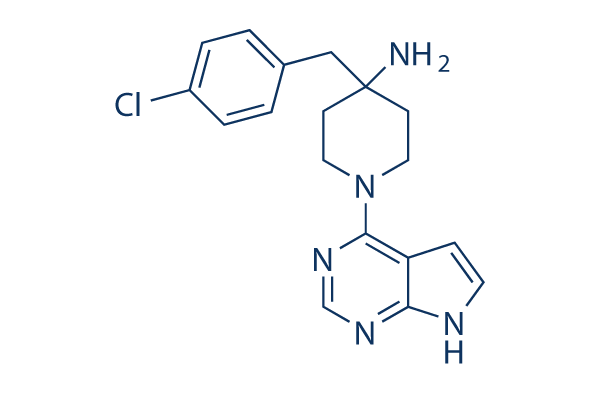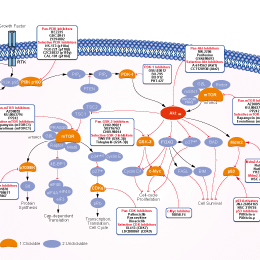
- Bioactive Compounds
- By Signaling Pathways
- PI3K/Akt/mTOR
- Epigenetics
- Methylation
- Immunology & Inflammation
- Protein Tyrosine Kinase
- Angiogenesis
- Apoptosis
- Autophagy
- ER stress & UPR
- JAK/STAT
- MAPK
- Cytoskeletal Signaling
- Cell Cycle
- TGF-beta/Smad
- DNA Damage/DNA Repair
- Compound Libraries
- Popular Compound Libraries
- Customize Library
- Clinical and FDA-approved Related
- Bioactive Compound Libraries
- Inhibitor Related
- Natural Product Related
- Metabolism Related
- Cell Death Related
- By Signaling Pathway
- By Disease
- Anti-infection and Antiviral Related
- Neuronal and Immunology Related
- Fragment and Covalent Related
- FDA-approved Drug Library
- FDA-approved & Passed Phase I Drug Library
- Preclinical/Clinical Compound Library
- Bioactive Compound Library-I
- Bioactive Compound Library-Ⅱ
- Kinase Inhibitor Library
- Express-Pick Library
- Natural Product Library
- Human Endogenous Metabolite Compound Library
- Alkaloid Compound LibraryNew
- Angiogenesis Related compound Library
- Anti-Aging Compound Library
- Anti-alzheimer Disease Compound Library
- Antibiotics compound Library
- Anti-cancer Compound Library
- Anti-cancer Compound Library-Ⅱ
- Anti-cancer Metabolism Compound Library
- Anti-Cardiovascular Disease Compound Library
- Anti-diabetic Compound Library
- Anti-infection Compound Library
- Antioxidant Compound Library
- Anti-parasitic Compound Library
- Antiviral Compound Library
- Apoptosis Compound Library
- Autophagy Compound Library
- Calcium Channel Blocker LibraryNew
- Cambridge Cancer Compound Library
- Carbohydrate Metabolism Compound LibraryNew
- Cell Cycle compound library
- CNS-Penetrant Compound Library
- Covalent Inhibitor Library
- Cytokine Inhibitor LibraryNew
- Cytoskeletal Signaling Pathway Compound Library
- DNA Damage/DNA Repair compound Library
- Drug-like Compound Library
- Endoplasmic Reticulum Stress Compound Library
- Epigenetics Compound Library
- Exosome Secretion Related Compound LibraryNew
- FDA-approved Anticancer Drug LibraryNew
- Ferroptosis Compound Library
- Flavonoid Compound Library
- Fragment Library
- Glutamine Metabolism Compound Library
- Glycolysis Compound Library
- GPCR Compound Library
- Gut Microbial Metabolite Library
- HIF-1 Signaling Pathway Compound Library
- Highly Selective Inhibitor Library
- Histone modification compound library
- HTS Library for Drug Discovery
- Human Hormone Related Compound LibraryNew
- Human Transcription Factor Compound LibraryNew
- Immunology/Inflammation Compound Library
- Inhibitor Library
- Ion Channel Ligand Library
- JAK/STAT compound library
- Lipid Metabolism Compound LibraryNew
- Macrocyclic Compound Library
- MAPK Inhibitor Library
- Medicine Food Homology Compound Library
- Metabolism Compound Library
- Methylation Compound Library
- Mouse Metabolite Compound LibraryNew
- Natural Organic Compound Library
- Neuronal Signaling Compound Library
- NF-κB Signaling Compound Library
- Nucleoside Analogue Library
- Obesity Compound Library
- Oxidative Stress Compound LibraryNew
- Plant Extract Library
- Phenotypic Screening Library
- PI3K/Akt Inhibitor Library
- Protease Inhibitor Library
- Protein-protein Interaction Inhibitor Library
- Pyroptosis Compound Library
- Small Molecule Immuno-Oncology Compound Library
- Mitochondria-Targeted Compound LibraryNew
- Stem Cell Differentiation Compound LibraryNew
- Stem Cell Signaling Compound Library
- Natural Phenol Compound LibraryNew
- Natural Terpenoid Compound LibraryNew
- TGF-beta/Smad compound library
- Traditional Chinese Medicine Library
- Tyrosine Kinase Inhibitor Library
- Ubiquitination Compound Library
-
Cherry Picking
You can personalize your library with chemicals from within Selleck's inventory. Build the right library for your research endeavors by choosing from compounds in all of our available libraries.
Please contact us at [email protected] to customize your library.
You could select:
- Antibodies
- Bioreagents
- qPCR
- 2x SYBR Green qPCR Master Mix
- 2x SYBR Green qPCR Master Mix(Low ROX)
- 2x SYBR Green qPCR Master Mix(High ROX)
- Protein Assay
- Protein A/G Magnetic Beads for IP
- Anti-Flag magnetic beads
- Anti-Flag Affinity Gel
- Anti-Myc magnetic beads
- Anti-HA magnetic beads
- Magnetic Separator
- Poly DYKDDDDK Tag Peptide lyophilized powder
- Protease Inhibitor Cocktail
- Protease Inhibitor Cocktail (EDTA-Free, 100X in DMSO)
- Phosphatase Inhibitor Cocktail (2 Tubes, 100X)
- Cell Biology
- Cell Counting Kit-8 (CCK-8)
- Animal Experiment
- Mouse Direct PCR Kit (For Genotyping)
- New Products
- Contact Us
CCT128930
CCT128930 is a potent, ATP-competitive and selective inhibitor of Akt2 with IC50 of 6 nM in a cell-free assay, 28-fold greater selectivity for Akt2 than the closely related PKA kinase. CCT128930 induces cell cycle arrest, DNA damage, and autophagy independent of Akt inhibition. High dose of CCT128930 triggers cell apoptosis in HepG2 cells.

CCT128930 Chemical Structure
CAS No. 885499-61-6
Purity & Quality Control
CCT128930 Related Products
| Related Targets | Akt1 Akt2 Akt3 | Click to Expand |
|---|---|---|
| Related Products | MK-2206 2HCl Perifosine SC79 Capivasertib (AZD5363) GSK690693 Ipatasertib (GDC-0068) Triciribine (API-2) Afuresertib (GSK2110183) A-674563 HCl AT7867 Oridonin Akti-1/2 PHT-427 Miransertib (ARQ 092) HCl AT13148 Uprosertib (GSK2141795) Miransertib (ARQ-092) SC66 Deguelin ML-9 HCl | Click to Expand |
| Related Compound Libraries | Kinase Inhibitor Library PI3K/Akt Inhibitor Library Apoptosis Compound Library Cell Cycle compound library NF-κB Signaling Compound Library | Click to Expand |
Signaling Pathway
Cell Data
| Cell Lines | Assay Type | Concentration | Incubation Time | Formulation | Activity Description | PMID |
|---|---|---|---|---|---|---|
| U87MG cells | Function assay | Inhibition of PKB in human U87MG cells assessed as GSK3-beta phosphorylation by ELISA, IC50=0.66 nM | 20151677 | |||
| PC3M cells | Function assay | Inhibition of PKB in human PC3M cells assessed as GSK3-beta phosphorylation by ELISA, IC50=0.003 μM | 20151677 | |||
| Click to View More Cell Line Experimental Data | ||||||
Biological Activity
| Description | CCT128930 is a potent, ATP-competitive and selective inhibitor of Akt2 with IC50 of 6 nM in a cell-free assay, 28-fold greater selectivity for Akt2 than the closely related PKA kinase. CCT128930 induces cell cycle arrest, DNA damage, and autophagy independent of Akt inhibition. High dose of CCT128930 triggers cell apoptosis in HepG2 cells. | ||||||
|---|---|---|---|---|---|---|---|
| Targets |
|
| In vitro | ||||
| In vitro | CCT128930 exhibits marked antiproliferative activity against PTEN-deficient human tumor cell lines including U87MG human glioblastoma cells, LNCaP human prostate cancer cells and PC3 human prostate cancer cells with GI50 of 6.3 μM, 0.35 μM and 1.9 μM, respectively. Furthermore, CCT128930 causes a G1 arrest in PTEN-null U87MG human glioblastoma cells and Akt pathway blockade. [1] | |||
|---|---|---|---|---|
| Kinase Assay | Kinase assays | |||
| Profiling against 50 different human kinases is carried out using 10 μM CCT128930 at an ATP concentration equivalent to the Km for each enzyme. | ||||
| Cell Research | Cell lines | U87MG, LNCaP and PC3 cells | ||
| Concentrations | 0-18.9 μM | |||
| Incubation Time | 48 hours | |||
| Method | Cells are seeded in 96-well plates and allowed to attach for 36 hours to ensure exponential growth prior to treatment. In vitro antiproliferative activity is determined using a 96-hour SRB assay. TCA-fixed cells are stained for 30 minutes with 0.4% (wt/vol) SRB dissolved in 1% acetic acid. At the end of the staining period, SRB is removed and cultures are quickly rinsed four times with 1% acetic acid to remove unbound dye. The acetic acid is poured directly into the culture wells from a beaker. This procedure permits rinsing to be performed quickly so that desorption of protein-bound dye does not occur. Residual wash solution is removed by sharply flicking plates over a sink, which ensures the complete removal of rinsing solution. Because of the strong capillary action in 96-well plates, draining by gravity alone often fails to remove the rinse solution when plates are simply inverted. After being rinsed, the cultures are air dried until no standing moisture is visible. Bound dye is solubilized with 10 mM unbuffered Tris base (pH 10.5) for 5 minutes on a gyratory shaker. OD is read in either a UVmax microtiter plate reader or a Beckman DU-70 spectrophotometer. For maximum sensitivity, OD is measured at 564 nm. Because readings are linear with dye concentrations only below 1.8 OD units, however, suboptimal wavelengths are generally used, so that all samples in an experiment remains within the linear OD range. With most cell lines, wavelengths of approximately 490-530 nm works well for this purpose. | |||
| In Vivo | ||
| In vivo | CCT128930 at 25 mg/kg i.p. shows a marked antitumor effect in established PTEN-null U87MG human glioblastoma xenografts with a treated:control (T/C) ratio of 48% on day 12. In HER2-positive, PIK3CA-mutant BT474 human breast cancer xenografts, CCT128930 at 40 mg/kg also produces a profound antitumor effect with complete growth arrest and a T/C ratio of 29% on day 22. CCT128930 administrated via i.v. reaches a peak concentration of 6.4 μM in plasma and is eliminated with a relatively short half-life, high volume of distribution, and rapid clearance, giving an area under the curve AUC0-∞ of 4.6 μM h. CCT128930 administrated via i.p. leads to the peak plasma drug concentration of 1.3 μM and the corresponding AUC0-∞ of 1.3 μM·h. Oral CCT128930 administration leads to the peak plasma concentration of only 0.43 μM and a correspondingly low AUC0-∞ of 0.4 μM·h. [1] | |
|---|---|---|
| Animal Research | Animal Models | PTEN-null U87MG human glioblastoma cells are injected subcutaneously (s.c.) in the right flank of female CrTacNCr-Fox1nu mice. For HER2-positive, PIK3CA-mutant BT474 human breast cancer xenografts, cells are administered s.c. in medium supplemented with M |
| Dosages | ≤50 mg/kg | |
| Administration | Administered via i.p. | |
Chemical Information & Solubility
| Molecular Weight | 341.84 | Formula | C18H20ClN5 |
| CAS No. | 885499-61-6 | SDF | Download CCT128930 SDF |
| Smiles | C1CN(CCC1(CC2=CC=C(C=C2)Cl)N)C3=NC=NC4=C3C=CN4 | ||
| Storage (From the date of receipt) | |||
|
In vitro |
DMSO : 25 mg/mL ( (73.13 mM) Moisture-absorbing DMSO reduces solubility. Please use fresh DMSO.) Ethanol : 5 mg/mL Water : Insoluble |
Molecular Weight Calculator |
|
In vivo Add solvents to the product individually and in order. |
In vivo Formulation Calculator |
||||
Preparing Stock Solutions
Molarity Calculator
In vivo Formulation Calculator (Clear solution)
Step 1: Enter information below (Recommended: An additional animal making an allowance for loss during the experiment)
mg/kg
g
μL
Step 2: Enter the in vivo formulation (This is only the calculator, not formulation. Please contact us first if there is no in vivo formulation at the solubility Section.)
% DMSO
%
% Tween 80
% ddH2O
%DMSO
%
Calculation results:
Working concentration: mg/ml;
Method for preparing DMSO master liquid: mg drug pre-dissolved in μL DMSO ( Master liquid concentration mg/mL, Please contact us first if the concentration exceeds the DMSO solubility of the batch of drug. )
Method for preparing in vivo formulation: Take μL DMSO master liquid, next addμL PEG300, mix and clarify, next addμL Tween 80, mix and clarify, next add μL ddH2O, mix and clarify.
Method for preparing in vivo formulation: Take μL DMSO master liquid, next add μL Corn oil, mix and clarify.
Note: 1. Please make sure the liquid is clear before adding the next solvent.
2. Be sure to add the solvent(s) in order. You must ensure that the solution obtained, in the previous addition, is a clear solution before proceeding to add the next solvent. Physical methods such
as vortex, ultrasound or hot water bath can be used to aid dissolving.
Tech Support
Answers to questions you may have can be found in the inhibitor handling instructions. Topics include how to prepare stock solutions, how to store inhibitors, and issues that need special attention for cell-based assays and animal experiments.
Tel: +1-832-582-8158 Ext:3
If you have any other enquiries, please leave a message.
* Indicates a Required Field
Tags: buy CCT128930 | CCT128930 supplier | purchase CCT128930 | CCT128930 cost | CCT128930 manufacturer | order CCT128930 | CCT128930 distributor







































